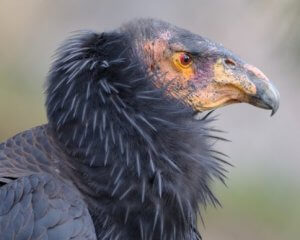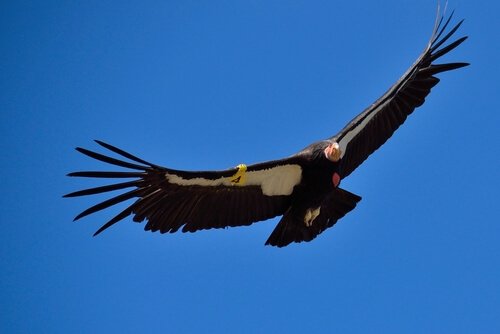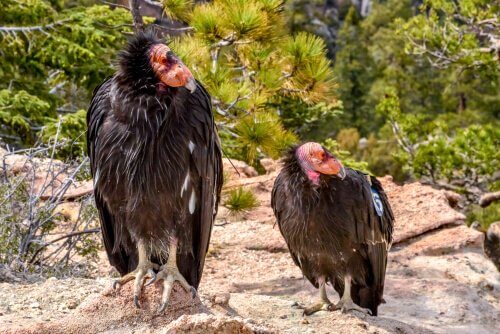California Condor: Part of Nature's Cleaning Team

The California condor is the largest flying land bird in North America and it once dominated the western skies. Unfortunately, the species declined during much of the 20th century until drastic measures were set in place to keep it from extinction.
California’s condor population plummeted to just 22 specimens in the world in the late 1970s. The last group of free-flight condors was taken into captivity in 1987 to save the species. Efforts to reintroduce condors began in 1992 and continue in the present day.
Anatomy and habitat of the California condor
The specimens of this beautiful bird are between 46 to 55 inches long from head to tail. In addition, while there’s definitely sexual dimorphism, the differences in size are minimal; as usual, the male is larger than the female.
On this note, the wingspan of an adult of this species can reach about 10 feet when extended. Also, the California condor is black with white spots and has a bald head with a few feathers on it. The color of the head varies from white to orange and reddish purple.
The naked head of the California condor is an adaptation for hygiene, because they eat dead and rotten meat. This is because they put their heads inside the corpses in order to eat.

Condors live in rocky and forested regions that include canyons and mountains. Besides that, they also roam around the coastal mountains of central and southern California. Their permanent nesting sites must have rocky cliffs and debris to build their nests comfortably and safely.
Feeding habits
The California condor’s diet is rather unappetizing for humans, although it’s vital for the ecosystem. The fact is that these birds are a huge part of nature’s cleaning team, playing a vital role in the safe removal of dead animals.
A healthy population of such carrion eaters has a major impact on the environment. In general, condors prefer the carcasses of larger animals such as deer, cattle, and sheep. However, they also feed on rabbits and squirrels.
Note that, even though condors prefer fresh carcasses, they also eat highly decomposed animals if necessary.
Condors can fly about 12 miles a day looking for food, and find their food thanks to their visual sharpness. Adult individuals require up to 3 1/2 pounds of meat per day although some can consume double that.
Conservation efforts

Unfortunately, the California Condor is on the verge of extinction. For example, there were three individuals, all males, living free in late 1986. That was a drop from the fifteen wild birds (including five breeding pairs) that were alive in 1984.
After several years of a successful captive breeding program in Los Angeles and San Diego, some specimens were reintroduced in the 1990s.
Only time will tell, but the condor case shows how important it is to help with key conservation tasks such as protecting relatively undisturbed habitats.
Reproduction of California condor
Since the 1990s, more than 120 California condors were reintroduced into their wild habitat but the mortality rate is still high. Moreover, the socialization of birds raised in captivity is difficult. Subsequently, it continues with the preservation of the species in captivity with a long-term plan for their continuous reproduction.
The exact causes of the rapid decline of California condors in the last decade are uncertain. However, well-known factors that do contribute to the decline of the species include poisoning, chemical contamination, reduction and loss of their natural habitat, and scarce food resources.
The consumption of poisoned bait meat placed by ranchers for coyotes is one of the reported cause of condor deaths. As is the lead poisoning from the bullets inside the animals killed by ranchers.
Mating habits
The average life span of the California condor is 37 years in captivity and 45 in their natural habitat. Their reproductive stage begins around their sixth year of age. Then, upon reaching full maturity, the males start their courtship by spreading their wings and swaying from side to side.
Then, once a female agrees to the proposal of a male, they mate for life. They lay one egg every two years and its incubation period is approximately 56 days; the eggs hatch between February and April.
California condors build their nests in caves next to cliffs or between rocky outcrops and crevices. Furthermore, both parents are responsible for the egg until the birth of their chick who’ll depend on their care for a year before leaving the nest.
The California condor is the largest flying land bird in North America and it once dominated the western skies. Unfortunately, the species declined during much of the 20th century until drastic measures were set in place to keep it from extinction.
California’s condor population plummeted to just 22 specimens in the world in the late 1970s. The last group of free-flight condors was taken into captivity in 1987 to save the species. Efforts to reintroduce condors began in 1992 and continue in the present day.
Anatomy and habitat of the California condor
The specimens of this beautiful bird are between 46 to 55 inches long from head to tail. In addition, while there’s definitely sexual dimorphism, the differences in size are minimal; as usual, the male is larger than the female.
On this note, the wingspan of an adult of this species can reach about 10 feet when extended. Also, the California condor is black with white spots and has a bald head with a few feathers on it. The color of the head varies from white to orange and reddish purple.
The naked head of the California condor is an adaptation for hygiene, because they eat dead and rotten meat. This is because they put their heads inside the corpses in order to eat.

Condors live in rocky and forested regions that include canyons and mountains. Besides that, they also roam around the coastal mountains of central and southern California. Their permanent nesting sites must have rocky cliffs and debris to build their nests comfortably and safely.
Feeding habits
The California condor’s diet is rather unappetizing for humans, although it’s vital for the ecosystem. The fact is that these birds are a huge part of nature’s cleaning team, playing a vital role in the safe removal of dead animals.
A healthy population of such carrion eaters has a major impact on the environment. In general, condors prefer the carcasses of larger animals such as deer, cattle, and sheep. However, they also feed on rabbits and squirrels.
Note that, even though condors prefer fresh carcasses, they also eat highly decomposed animals if necessary.
Condors can fly about 12 miles a day looking for food, and find their food thanks to their visual sharpness. Adult individuals require up to 3 1/2 pounds of meat per day although some can consume double that.
Conservation efforts

Unfortunately, the California Condor is on the verge of extinction. For example, there were three individuals, all males, living free in late 1986. That was a drop from the fifteen wild birds (including five breeding pairs) that were alive in 1984.
After several years of a successful captive breeding program in Los Angeles and San Diego, some specimens were reintroduced in the 1990s.
Only time will tell, but the condor case shows how important it is to help with key conservation tasks such as protecting relatively undisturbed habitats.
Reproduction of California condor
Since the 1990s, more than 120 California condors were reintroduced into their wild habitat but the mortality rate is still high. Moreover, the socialization of birds raised in captivity is difficult. Subsequently, it continues with the preservation of the species in captivity with a long-term plan for their continuous reproduction.
The exact causes of the rapid decline of California condors in the last decade are uncertain. However, well-known factors that do contribute to the decline of the species include poisoning, chemical contamination, reduction and loss of their natural habitat, and scarce food resources.
The consumption of poisoned bait meat placed by ranchers for coyotes is one of the reported cause of condor deaths. As is the lead poisoning from the bullets inside the animals killed by ranchers.
Mating habits
The average life span of the California condor is 37 years in captivity and 45 in their natural habitat. Their reproductive stage begins around their sixth year of age. Then, upon reaching full maturity, the males start their courtship by spreading their wings and swaying from side to side.
Then, once a female agrees to the proposal of a male, they mate for life. They lay one egg every two years and its incubation period is approximately 56 days; the eggs hatch between February and April.
California condors build their nests in caves next to cliffs or between rocky outcrops and crevices. Furthermore, both parents are responsible for the egg until the birth of their chick who’ll depend on their care for a year before leaving the nest.
This text is provided for informational purposes only and does not replace consultation with a professional. If in doubt, consult your specialist.








